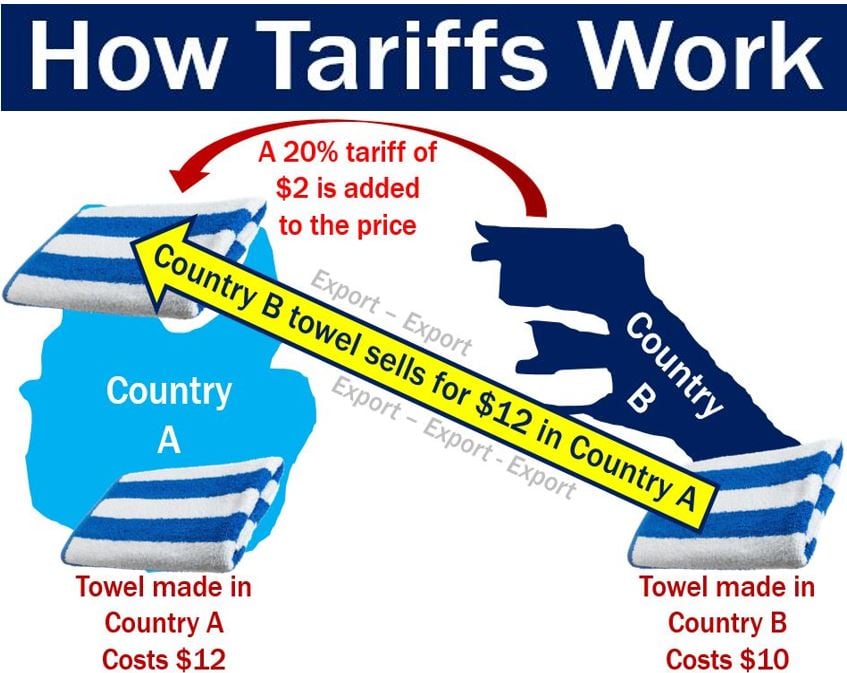Analysis: Trump's China Tariffs And Their Projected Lifespan

Table of Contents
The imposition of tariffs on Chinese goods by the Trump administration marked a significant turning point in US-China relations, igniting a protracted trade war that continues to reverberate through the global economy. This analysis delves into the lasting effects of these Trump China tariffs, examining their projected lifespan and evaluating their multifaceted impact. We will explore the factors influencing their potential removal or continuation and consider future implications for both the United States and China.
The Initial Implementation and Rationale of Trump's China Tariffs
The escalation of tariffs under the Trump administration stemmed from long-simmering tensions concerning the US-China trade deficit, accusations of intellectual property theft, and concerns over unfair trade practices. These issues had been brewing for years, but the Trump administration adopted a more aggressive approach, framing the tariffs as necessary to protect American industries and force concessions from China.
- Trade Deficit: A persistent and growing trade deficit with China fueled the narrative of unfair trade practices.
- Intellectual Property Theft: The administration alleged widespread theft of intellectual property by Chinese companies, costing American businesses billions of dollars.
- Section 301 Tariffs: The tariffs were largely imposed under Section 301 of the Trade Act of 1974, which allows the president to take action against unfair trade practices.
- National Security Concerns: Some tariffs were justified on national security grounds, targeting strategically important sectors.
The stated goals of the tariffs included:
- Protecting American jobs and industries.
- Leveling the playing field for American businesses.
- Forcing China to address intellectual property theft and other unfair trade practices.
Economic Impacts of the Tariffs: Winners and Losers
The Trump China tariffs had far-reaching economic consequences, impacting both consumers and businesses in the US and China. While some sectors benefited from increased protection, many others experienced negative impacts.
Impact on US Consumers:
- Increased Prices: Tariffs led to higher prices for numerous goods, contributing to inflation.
- Reduced Consumer Choice: Some products became less available or more expensive, limiting consumer choices.
Impact on US Businesses:
- Increased Input Costs: Businesses reliant on imported Chinese goods faced significantly increased input costs.
- Reduced Competitiveness: Higher costs made some US businesses less competitive in both domestic and international markets.
Impact on China:
- Retaliatory Tariffs: China responded with its own retaliatory tariffs, harming Chinese exporters.
- Decreased Exports: Chinese exports to the US declined, impacting economic growth and employment in certain sectors.
Specific Sectors Affected:
- Positively Affected (US): Certain agricultural sectors initially experienced increased domestic demand due to reduced imports.
- Negatively Affected (US): Manufacturing, retail, and consumer goods sectors faced higher costs and reduced sales.
- Negatively Affected (China): Numerous export-oriented industries, particularly in manufacturing and technology, were severely impacted.
The Biden Administration's Approach to Trump's China Tariffs
The Biden administration inherited a complex and contentious trade relationship with China, including the existing tariff structure. While the Biden administration has expressed concerns about China's trade practices, their approach differs significantly from Trump's.
- Tariff Review: The Biden administration has undertaken reviews of the existing tariffs, aiming for a more targeted and strategic approach.
- Targeted Exemptions: Some tariffs have been removed or modified, offering targeted exemptions for specific goods.
- Trade Negotiations: The administration has engaged in ongoing, albeit complex, trade negotiations with China, seeking to address areas of concern without resorting to widespread tariff increases.
- Focus on Multilateralism: The Biden administration has prioritized cooperation with allies, contrasting with Trump's more unilateral approach.
Factors Influencing the Projected Lifespan of the Tariffs
The projected lifespan of the Trump China tariffs hinges on a complex interplay of political, economic, and geopolitical factors.
- Political Landscape: Domestic political pressures, including lobbying efforts from affected industries, continue to influence tariff decisions. Elections and shifts in political power can dramatically alter trade policy.
- Economic Interdependence: The high degree of economic interdependence between the US and China complicates efforts to fully remove the tariffs. Complete removal could have unforeseen economic consequences for both countries.
- Global Supply Chain Disruptions: Global events, such as the COVID-19 pandemic, have highlighted the vulnerabilities of complex global supply chains, influencing decisions on tariff policies.
- International Trade Organizations: The role of organizations like the World Trade Organization (WTO) and adherence to international trade agreements influence the legitimacy and sustainability of tariff measures.
The Role of Domestic Political Pressure
Powerful lobbying groups representing affected industries exert considerable influence on tariff policy. These groups advocate for the continuation or removal of tariffs based on their specific interests.
The Impact of Global Supply Chain Disruptions
Global events like the pandemic have underscored the interconnectedness of global supply chains and highlighted the potential downsides of overly protectionist trade policies. These disruptions can shift political calculations regarding tariff continuation.
Conclusion
This analysis reveals that the lifespan of Trump's China tariffs is far from certain. The complex interplay of economic and political factors dictates their future. Significant economic impacts on both the US and China—with both winners and losers— underscore the need for careful consideration. The uncertainties surrounding these tariffs under the current geopolitical climate remain significant. While the Biden administration has taken a more nuanced approach, the possibility of complete removal, partial removal, or even further escalation remains open.
Call to Action: To stay informed on the evolving landscape of US-China trade relations and the future of these significant trade policies, continue to monitor developments and analysis regarding Trump's China tariffs and their projected lifespan. Further research into the economic consequences and ongoing negotiations is crucial for understanding the long-term implications of this pivotal trade policy.

Featured Posts
-
 Teslas Legal Maneuvers Blocking Shareholder Lawsuits Post Musk Compensation Controversy
May 18, 2025
Teslas Legal Maneuvers Blocking Shareholder Lawsuits Post Musk Compensation Controversy
May 18, 2025 -
 The China Factor Analyzing The Difficulties Faced By Luxury Car Brands
May 18, 2025
The China Factor Analyzing The Difficulties Faced By Luxury Car Brands
May 18, 2025 -
 Nederlandse Vuurwerkliefhebbers Ondanks Verbod
May 18, 2025
Nederlandse Vuurwerkliefhebbers Ondanks Verbod
May 18, 2025 -
 Ben Joyce Learning From Kenley Jansens La Angels Experience
May 18, 2025
Ben Joyce Learning From Kenley Jansens La Angels Experience
May 18, 2025 -
 Angels Defeat White Sox 1 0 Moncada And Soriano Shine
May 18, 2025
Angels Defeat White Sox 1 0 Moncada And Soriano Shine
May 18, 2025
Latest Posts
-
 Amanda Bynes Only Fans 50 Monthly Subscription After 15 Year Acting Hiatus
May 18, 2025
Amanda Bynes Only Fans 50 Monthly Subscription After 15 Year Acting Hiatus
May 18, 2025 -
 Amanda Bynes Only Fans A Post Hollywood Career Path
May 18, 2025
Amanda Bynes Only Fans A Post Hollywood Career Path
May 18, 2025 -
 Watch Easy A On Bbc Three Hd Your Guide To Airtimes
May 18, 2025
Watch Easy A On Bbc Three Hd Your Guide To Airtimes
May 18, 2025 -
 Find Easy A On Bbc Three Hd Your Complete Tv Guide
May 18, 2025
Find Easy A On Bbc Three Hd Your Complete Tv Guide
May 18, 2025 -
 Taran Killam Discusses His Friendship With Amanda Bynes
May 18, 2025
Taran Killam Discusses His Friendship With Amanda Bynes
May 18, 2025
